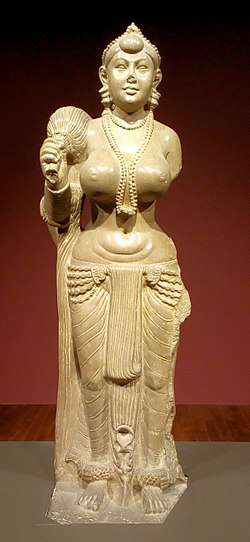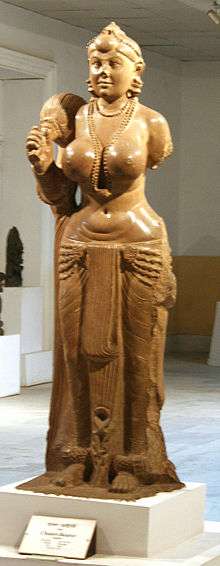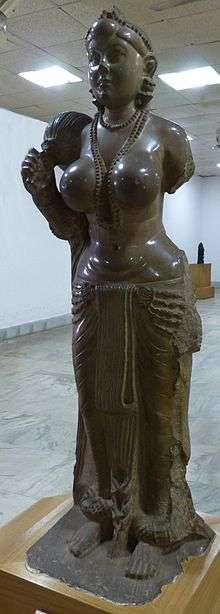Didarganj Yakshi
| Didarganj Yakshi | |
|---|---|
 Didarganj Yakshi (Chauri Bearer), Bihar Museum. | |
| Material | Polished sandstone |
| Size |
Height: Width: |
| Period/culture | 2nd century CE |
| Discovered | 25°34'18"N 85°15'45"E |
| Place | Didarganj, Patna, Bihar, India. |
| Present location | Bihar Museum, India |
 Discovery | |
The Didarganj Yakshi (or Didarganj Chauri Bearer; Hindi: दीदारगंज यक्षी) is sometimes considered as one of the finest examples of Mauryan art.[1] Alternatively, it is rather dated to the 2nd century CE, based on the analysis of shape and ornamentation.[2][3][4] The treatment of the forelock in particular is said to be characteristically Kushan.[5]
The sculpture is currently located in the Bihar Museum in Bihar, India.[6] It is 64" tall, carved out of a single piece of stone.[7] This life-size standing image is tall, well-proportioned, free-standing sculpture is made of sandstone with well polished surface, a characteristic usually associated with Mauryan polish. The Flywhisk (chauri) is held in the right hand whereas the left hand is broken. The lower garment create a somewhat transparent effect. The Didarganj Yakshi is estimated to date from ca. 3rd century BCE to the 2nd century CE.[8][9] It was excavated on the banks of the Ganges River, at the hamlet of Didarganj Kadam Basual, northeast of the Qadam-i-Rasul Mosque in Patna City, in October 1917 by noted archaeologist and historian, Professor J N Samaddar.[10]
 Another view, Patna Museum.
Another view, Patna Museum. Another view, Patna Museum.
Another view, Patna Museum. Side view.
Side view.
References
- ↑ Chaudhary, Pranava K (28 September 2006). "A fortress chockfull of chinks". Indiatimes. Retrieved 17 February 2011.
- ↑ "A History of Ancient and Early Medieval India: From the Stone Age to the 12th Century" by Upinder Singh, Pearson Education India, 2008
- ↑ ""Ayodhya, Archaeology After Demolition: A Critique of the "new" and "fresh" Discoveries", by Dhaneshwar Mandal, Orient Blackswan, 2003, p.46
- ↑ "A Companion to Asian Art and Architecture" by Deborah S. Hutton, John Wiley & Sons, 2015, p.435
- ↑ Pereira, Jose (2001). Monolithic Jinas. Motilal Banarsidass Publ. p. 11. ISBN 9788120823976.
- ↑ "This museum in Bihar houses a 2300-year-old sculpture carved out of a single stone".
- ↑ Bengal Archeology website, "Didarganj Yakshi" (7 March 2009) , accessed 30 August 2011.
- ↑ Huntington, John C. and Susan L., The Huntington Archive - Ohio State University , accessed 30 August 2011.
- ↑ "A History of Ancient and Early Medieval India: From the Stone Age to the 12th Century" by Upinder Singh, Pearson Education India, 2008
- ↑ Davis, Richard H. (1997). Lives of Indian Images. New Jersey: Princeton University Press.
External links
Coordinates: 25°34′18″N 85°15′45″E / 25.57167°N 85.26250°E